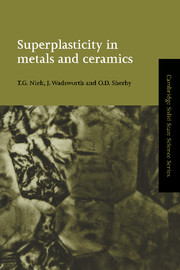Book contents
- Frontmatter
- Contents
- Preface
- Chapter 1 Introduction
- Chapter 2 Key historical contributions
- Chapter 3 Types of superplasticity
- Chapter 4 Mechanisms of high-temperature deformation and phenomenological relations for fine-structure superplasticity
- Chapter 5 Fine-structure superplastic metals
- Chapter 6 Fine-structure superplastic ceramics
- Chapter 7 Fine-structure superplastic intermetallics
- Chapter 8 Fine-structure superplastic composites and laminates
- Chapter 9 High-strain-rate superplasticity
- Chapter 10 Ductility and fracture in superplastic materials
- Chapter 11 Internal-stress superplasticity (ISS)
- Chapter 12 Other possible superplasticity mechanisms
- Chapter 13 Enhanced powder consolidation through superplastic flow
- Chapter 14 Superplastic forming and diffusion bonding
- Chapter 15 Commercial examples of superplastic products
- Index
Chapter 4 - Mechanisms of high-temperature deformation and phenomenological relations for fine-structure superplasticity
Published online by Cambridge University Press: 15 October 2009
- Frontmatter
- Contents
- Preface
- Chapter 1 Introduction
- Chapter 2 Key historical contributions
- Chapter 3 Types of superplasticity
- Chapter 4 Mechanisms of high-temperature deformation and phenomenological relations for fine-structure superplasticity
- Chapter 5 Fine-structure superplastic metals
- Chapter 6 Fine-structure superplastic ceramics
- Chapter 7 Fine-structure superplastic intermetallics
- Chapter 8 Fine-structure superplastic composites and laminates
- Chapter 9 High-strain-rate superplasticity
- Chapter 10 Ductility and fracture in superplastic materials
- Chapter 11 Internal-stress superplasticity (ISS)
- Chapter 12 Other possible superplasticity mechanisms
- Chapter 13 Enhanced powder consolidation through superplastic flow
- Chapter 14 Superplastic forming and diffusion bonding
- Chapter 15 Commercial examples of superplastic products
- Index
Summary
Creep mechanisms
Creep is a plastic deformation process that occurs in solids at high temperatures, typically, above approximately 0.5 of the homologous temperature, i.e. T/Tm, where Tm is the absolute melting point of the solid. During creep, a solid deforms permanently, under external forces, initially with negligible formation of cracks or voids. This capacity for plastic flow is associated with three discrete mechanisms that can occur at the atomic level. These mechanisms are (a) slip by dislocation movement, (b) sliding of adjacent grains along grain boundaries, and (c) directional diffusional flow. To a first approximation, the three mechanisms can be generally considered to occur independently of one another. Although, in some cases, one mechanism may be necessary to permit accommodation of another, e.g. diffusional flow or slip may be an accommodation mechanism for grain boundary sliding. For the case of large plastic strains, these mechanisms are all thermally activated and are controlled by the diffusion of atoms. They are, therefore, both temperature- and time-dependent.
Creep is commonly characterized by a strain–time curve, i.e. a creep curve. The creep rate is measured directly from the slope of such a creep curve. There are usually two basic types of creep curves: a metal type and an alloy type. As shown in Figure 4.1, for the metal type, the curve normally starts with a primary regime during which the creep rate decreases with time; this region is usually followed by a steady-state regime during which the creep rate is essentially constant; eventually, cavitation and necking begin to develop in the specimen which results in an acceleration of creep rate and leads to a tertiary region and the final failure.
- Type
- Chapter
- Information
- Superplasticity in Metals and Ceramics , pp. 32 - 57Publisher: Cambridge University PressPrint publication year: 1997
- 7
- Cited by

